Monitoring Critical Mountain Vertical Zonation in the Surkhan River Basin Based on a Comparative Analysis of Multi-Source Remote Sensing Features
Abstract
1. Introduction
2. Materials and Methods
2.1. Study Area
2.2. Data
2.2.1. Landsat Data
2.2.2. DEM Data
2.2.3. ERA5 Data
2.2.4. Nighttime Light Data
2.3. Methods
2.3.1. Dataset Preprocessing
2.3.2. Vertical Zonation Boundary Extraction
2.3.3. Land Surface Temperature
2.3.4. Potential Energy Analysis
2.3.5. Accuracy Assessment
3. Results
3.1. Land Cover Classification in the Surkhan River Basin
3.2. Mountain Vertical Zonation Results in the Surkhan River Basin
3.2.1. “DEM–NDVI–Land Cover Classification” Scatterplot Analysis
3.2.2. Results and Analysis of Mountain Vertical Zonation Extraction
3.3. Critical Transitions in Altitudinal Zonality
3.3.1. Temperate Desert Zone–Mountain Grassland Zone
3.3.2. Alpine Cushion Vegetation Zone–Snow/Ice Zone
3.3.3. Bistable Coexistence Zone
3.4. Driving Factor Analysis
3.4.1. Temperature Change Analysis
3.4.2. Night Lighting Data Analysis
4. Discussion
4.1. Regional Specificity and Methodological Comparison
4.2. Leveraging Bistable Transition Zones for Ecological Risk Assessment
4.3. Implications, Limitations, and Future Prospects
5. Conclusions
Author Contributions
Funding
Data Availability Statement
Acknowledgments
Conflicts of Interest
References
- Qu, S.; Wang, L.; Lin, A.; Zhu, H.; Yuan, M. What drives the vegetation restoration in Yangtze River basin, China: Climate change or anthropogenic factors? Ecol. Indic. 2018, 90, 438–450. [Google Scholar] [CrossRef]
- White, A.B.; Kumar, P.; Tcheng, D. A data mining approach for understanding topographic control on climate-induced inter-annual vegetation variability over the United States. Remote Sens. Environ. 2005, 98, 1–20. [Google Scholar] [CrossRef]
- Li, Q.; Lu, H.; Zhu, L.; Wu, N.; Wang, J.; Lu, X. Pollen-inferred climate changes and vertical shifts of alpine vegetation belts on the northern slope of the Nyainqentanglha Mountains (central Tibetan Plateau) since 8.4 kyr BP. Holocene 2011, 21, 939–950. [Google Scholar] [CrossRef]
- Biswas, O.; Ghosh, R.; Agrawal, S.; Morthekai, P.; Paruya, D.K.; Mukherjee, B.; Bera, M.; Bera, S. A comprehensive calibrated phytolith based climatic index from the Himalaya and its application in palaeotemperature reconstruction. Sci. Total Environ. 2021, 750, 142280. [Google Scholar] [CrossRef] [PubMed]
- Wang, H.; Song, Y.; Cheng, Y.; Luo, Y.; Zhang, C.n.; Gao, Y.; Qiu, A.a.; Deng, L.; Liu, H. Mineral magnetism and other characteristics of sediments from a sub-alpine lake (3080 m asl) in central east China and their implications on environmental changes for the last 5770 years. Earth Planet. Sci. Lett. 2016, 452, 44–59. [Google Scholar] [CrossRef]
- Zhu, C.; Liu, H.; Wang, H.; Feng, S.; Han, Y. Vegetation change at the southern boreal forest margin in Northeast China over the last millennium: The role of permafrost dynamics. Palaeogeogr. Palaeoclimatol. Palaeoecol. 2020, 558, 109959. [Google Scholar] [CrossRef]
- Wang, W.; He, Z.; Du, J.; Ma, D.; Zhao, P. Altitudinal patterns of species richness and flowering phenology in herbaceous community in Qilian Mountains of China. Int. J. Biometeorol. 2022, 66, 741–751. [Google Scholar] [CrossRef]
- Dullinger, S.; Dirnböck, T.; Grabherr, G. Modelling climate change-driven treeline shifts: Relative effects of temperature increase, dispersal and invasibility. J. Ecol. 2004, 92, 241–252. [Google Scholar] [CrossRef]
- Wamucii, C.N.; Van Oel, P.R.; Ligtenberg, A.; Gathenya, J.M.; Teuling, A.J. Land-use and climate change effects on water yield from East African Forested Water Towers. Hydrol. Earth Syst. Sci. Discuss. 2021, 2021, 1389–1406. [Google Scholar] [CrossRef]
- Anderle, M.; Paniccia, C.; Brambilla, M.; Hilpold, A.; Volani, S.; Tasser, E.; Seeber, J.; Tappeiner, U. The contribution of landscape features, climate and topography in shaping taxonomical and functional diversity of avian communities in a heterogeneous Alpine region. Oecologia 2022, 199, 499–512. [Google Scholar] [CrossRef]
- Xenarios, S.; Gafurov, A.; Schmidt-Vogt, D.; Sehring, J.; Manandhar, S.; Hergarten, C.; Shigaeva, J.; Foggin, M. Climate change and adaptation of mountain societies in Central Asia: Uncertainties, knowledge gaps, and data constraints. Reg. Environ. Change 2019, 19, 1339–1352. [Google Scholar] [CrossRef]
- LI, C.-g.; TAN, B.-z. Studies on the methods of mangrove inventory based on RS, GPS and GIS. J. Nat. Resour. 2003, 18, 215–221. [Google Scholar]
- Zhang, Q.; Zhsng, Y.; Luo, P.; Wang, Q.; Wu, N. Ecological characteristics of cypress population in yang-slope forest line of Baima Mountain. Chin. J. Plant Ecol 2007, 31, 857–864. [Google Scholar]
- Zhao, F.; Zhang, B.; Zhu, L.; Yao, Y.; Cui, Y.; Liu, J. Spectra structures of altitudinal belts and their significance for determining the boundary between warm temperate and subtropical zones in the Qinling-Daba Mountains. Acta Geogr. Sin 2019, 74, 889. [Google Scholar]
- Piiroinen, R.; Fassnacht, F.E.; Heiskanen, J.; Maeda, E.; Mack, B.; Pellikka, P. Invasive tree species detection in the Eastern Arc Mountains biodiversity hotspot using one class classification. Remote Sens. Environ. 2018, 218, 119–131. [Google Scholar] [CrossRef]
- Zhang, Y.; Wu, X.; Zheng, D. Vertical differentiation of land cover in the central Himalayas. J. Geogr. Sci. 2020, 30, 969–987. [Google Scholar] [CrossRef]
- Chen, W.; Ding, H.; Li, J.; Chen, K.; Wang, H. Alpine treelines as ecological indicators of global climate change: Who has studied? What has been studied? Ecol. Inform. 2022, 70, 101691. [Google Scholar] [CrossRef]
- Gao, M.; Piao, S.; Chen, A.; Yang, H.; Liu, Q.; Fu, Y.H.; Janssens, I.A. Divergent changes in the elevational gradient of vegetation activities over the last 30 years. Nat. Commun. 2019, 10, 2970. [Google Scholar] [CrossRef]
- Gómez, C.; White, J.C.; Wulder, M.A. Optical remotely sensed time series data for land cover classification: A review. ISPRS J. Photogramm. Remote Sens. 2016, 116, 55–72. [Google Scholar] [CrossRef]
- Xie, B.; Jia, X.; Qin, Z.; Shen, J.; Chang, Q. Vegetation dynamics and climate change on the Loess Plateau, China: 1982–2011. Reg. Environ. Change 2016, 16, 1583–1594. [Google Scholar] [CrossRef]
- Guo, D.; Zhang, H.-y.; Hou, G.-l.; Zhao, J.-j.; Liu, D.-y.; Guo, X.-y. Topographic controls on alpine treeline patterns on Changbai Mountain, China. J. Mt. Sci. 2014, 11, 429–441. [Google Scholar] [CrossRef]
- Danzeglocke, J.; Oluic, M. Remote sensing of upper timberline elevation in the Alps on different scales. In Proceedings of the 24th EARSeL Symp. New Strategies for European Remote Sensing, Dubrovnik, Croatia, 25–27 May 2005; pp. 25–27. [Google Scholar]
- Zhang, J.; Yao, Y.; Suonan, D.; Gao, L.; Wang, J.; Zhang, X. Mapping of mountain vegetation in Taibai Mountain based on mountain altitudinal belts with remote sensing. J. Geo-Inf. Sci. 2019, 21, 1284–1294. [Google Scholar]
- Gao, Y.; Huang, J.; Li, S.; Li, S. Spatial pattern of non-stationarity and scale-dependent relationships between NDVI and climatic factors—A case study in Qinghai-Tibet Plateau, China. Ecol. Indic. 2012, 20, 170–176. [Google Scholar] [CrossRef]
- Liu, Y.; Li, Z.; Chen, Y.; Li, Y.; Li, H.; Xia, Q.; Kayumba, P.M. Evaluation of consistency among three NDVI products applied to High Mountain Asia in 2000–2015. Remote Sens. Environ. 2022, 269, 112821. [Google Scholar] [CrossRef]
- Liu, M.; Zhao, R.; Shao, P.; Jiao, J.; Li, L.; Che, Y. Temporal and spatial variation of vegetation coverage and its driving forces in the Loess Plateau from 2001 to 2015. Arid Land Geogr. 2018, 41, 99–108. [Google Scholar]
- Berner, L.T.; Goetz, S.J. Satellite observations document trends consistent with a boreal forest biome shift. Glob. Change Biol. 2022, 28, 3275–3292. [Google Scholar] [CrossRef]
- Franke, A.; Feilhauer, H.; Bräuning, A.; Rautio, P.; Braun, M. Remotely sensed estimation of vegetation shifts in the polar and alpine tree-line ecotone in Finnish Lapland during the last three decades. For. Ecol. Manag. 2019, 454, 117668. [Google Scholar] [CrossRef]
- Bonney, M.T.; Danby, R.K.; Treitz, P.M. Landscape variability of vegetation change across the forest to tundra transition of central Canada. Remote Sens. Environ. 2018, 217, 18–29. [Google Scholar] [CrossRef]
- Chang, C.; Wang, X.; Yang, R.; Liu, C.; Luo, L.; Zhen, J.; Xiang, B.; Song, J.; Liao, Y. A quantitative characterization method for alpine vegetation zone based on DEM and NDVI. Geogr. Res. 2015, 34, 2113–2123. [Google Scholar]
- Ji, X.L.; Luo, L.; Wang, X.; Li, L.; Wan, H. Identification and change analysis of mountain altitudinal zone in Tianshan Bogda Natural Heritage Site based on “DEM-NDVI-Land Cover Classification”. J. Geo-Inf. Sci. 2018, 20, 1350–1360. [Google Scholar]
- Chen, X.; Wang, X.; Li, J.; Kang, D. Species diversity of primary and secondary forests in Wanglang Nature Reserve. Glob. Ecol. Conserv. 2020, 22, e01022. [Google Scholar] [CrossRef]
- Wan, H.; Wang, X.; Luo, L.; Guo, P.; Zhao, Y.; Wu, K.; Ren, H. Remotely-sensed identification of a transition for the two ecosystem states along the elevation gradient: A case study of Xinjiang Tianshan Bogda world heritage site. Remote Sens. 2019, 11, 2861. [Google Scholar] [CrossRef]
- Wan, H.; Guo, P.; Luo, L.; Zhao, Y.; Zhao, Y.; Wang, X. Quantitative identification of altitudinal natural zones of mountain vegetation based on ecosystem multi-stable states—A case study of Bogda Mountain in Xinjiang. Natl. Remote Sens. Bull. 2022, 26, 2234–2247. [Google Scholar] [CrossRef]
- Lioubimtseva, E.; Henebry, G.M. Climate and environmental change in arid Central Asia: Impacts, vulnerability, and adaptations. J. Arid Environ. 2009, 73, 963–977. [Google Scholar] [CrossRef]
- Malassé, A.D.; Gaillard, C. Relations between climatic changes and prehistoric human migrations during Holocene between Gissar Range, Pamir, Hindu Kush and Kashmir: The archaeological and ecological data. Quat. Int. 2011, 229, 123–131. [Google Scholar] [CrossRef]
- Worthington, J.R.; Kapp, P.; Minaev, V.; Chapman, J.B.; Mazdab, F.K.; Ducea, M.N.; Oimahmadov, I.; Gadoev, M. Birth, life, and demise of the Andean–syn-collisional Gissar arc: Late Paleozoic tectono-magmatic-metamorphic evolution of the southwestern Tian Shan, Tajikistan. Tectonics 2017, 36, 1861–1912. [Google Scholar] [CrossRef]
- Konopelko, D.; Seltmann, R.; Mamadjanov, Y.; Romer, R.; Rojas-Agramonte, Y.; Jeffries, T.; Fidaev, D.; Niyozov, A. A geotraverse across two paleo-subduction zones in Tien Shan, Tajikistan. Gondwana Res. 2017, 47, 110–130. [Google Scholar] [CrossRef]
- Saribaeva, H.S.; Abduraimov, O.; Allamuratov, A. Assessment of the population status of Allium oschaninii O. Fedtsch. in the mountains of Uzbekistan. Ekológia 2022, 41, 147–154. [Google Scholar] [CrossRef]
- Hagg, W.; Braun, L. The influence of glacier retreat on water yield from high mountain areas: Comparison of Alps and central Asia. Clim. Hydrol. Mt. Areas 2005, 18, 263–275. [Google Scholar]
- Li, X.; Zhou, Y.; Zhao, M.; Zhao, X. A harmonized global nighttime light dataset 1992–2018. Sci. Data 2020, 7, 168. [Google Scholar] [CrossRef] [PubMed]
- Prakash Singh, C.; Mohapatra, J.; Pandya, H.A.; Gajmer, B.; Sharma, N.; Shrestha, D.G. Evaluating changes in treeline position and land surface phenology in Sikkim Himalaya. Geocarto Int. 2020, 35, 453–469. [Google Scholar] [CrossRef]
- Mohapatra, J.; Singh, C.P.; Tripathi, O.P.; Pandya, H.A. Remote sensing of alpine treeline ecotone dynamics and phenology in Arunachal Pradesh Himalaya. Int. J. Remote Sens. 2019, 40, 7986–8009. [Google Scholar] [CrossRef]
- Danzeglocke, J.; Menz, G. Analysis of upper timberline elevation in the European Alps using MODIS data. In Proceedings of the IGARSS 2004, 2004 IEEE International Geoscience and Remote Sensing Symposium, Anchorage, AK, USA, 20–24 September 2004; pp. 2373–2376. [Google Scholar]
- Zhao, T.; Bai, H.; Han, H.; Ta, Z.; Li, P.; Wang, P. A Quantitatively Divided Approach for the Vertical Belt of Vegetation Based on NDVI and DEM—An Analysis of Taibai Mountain. Forests 2023, 14, 1981. [Google Scholar] [CrossRef]
- Chatterjee, R.; Singh, N.; Thapa, S.; Sharma, D.; Kumar, D. Retrieval of land surface temperature (LST) from landsat TM6 and TIRS data by single channel radiative transfer algorithm using satellite and ground-based inputs. Int. J. Appl. Earth Obs. Geoinf. 2017, 58, 264–277. [Google Scholar] [CrossRef]
- Qin, Z.; Karnieli, A.; Berliner, P. A mono-window algorithm for retrieving land surface temperature from Landsat TM data and its application to the Israel-Egypt border region. Int. J. Remote Sens. 2001, 22, 3719–3746. [Google Scholar] [CrossRef]
- Bendib, A.; Dridi, H.; Kalla, M.I. Contribution of Landsat 8 data for the estimation of land surface temperature in Batna city, Eastern Algeria. Geocarto Int. 2017, 32, 503–513. [Google Scholar] [CrossRef]
- Sobrino, J.A.; Jiménez-Muñoz, J.C.; Paolini, L. Land surface temperature retrieval from LANDSAT TM 5. Remote Sens. Environ. 2004, 90, 434–440. [Google Scholar] [CrossRef]
- Jimenez-Munoz, J.C.; Sobrino, J.A.; Skoković, D.; Mattar, C.; Cristobal, J. Land surface temperature retrieval methods from Landsat-8 thermal infrared sensor data. IEEE Geosci. Remote Sens. Lett. 2014, 11, 1840–1843. [Google Scholar] [CrossRef]
- Wang, K.; Jiang, Q.-g.; Yu, D.-h.; Yang, Q.-l.; Wang, L.; Han, T.-c.; Xu, X.-y. Detecting daytime and nighttime land surface temperature anomalies using thermal infrared remote sensing in Dandong geothermal prospect. Int. J. Appl. Earth Obs. Geoinf. 2019, 80, 196–205. [Google Scholar] [CrossRef]
- Li, S.; Jiang, G.-M. Land surface temperature retrieval from Landsat-8 data with the generalized split-window algorithm. IEEE Access 2018, 6, 18149–18162. [Google Scholar] [CrossRef]
- Wang, F.; Qin, Z.; Song, C.; Tu, L.; Karnieli, A.; Zhao, S. An improved mono-window algorithm for land surface temperature retrieval from Landsat 8 thermal infrared sensor data. Remote Sens. 2015, 7, 4268–4289. [Google Scholar] [CrossRef]
- Hu, D.; Qiao, K.; Wang, X.; Zhao, L.; Ji, G. Comparison of three single-window algorithms for retrieving land-surface temperature with Landsat 8 TIRS data. Geomat. Inf. Sci. Wuhan Univ. 2017, 42, 869–876. [Google Scholar]
- Cristóbal, J.; Jiménez-Muñoz, J.; Sobrino, J.; Ninyerola, M.; Pons, X. Improvements in land surface temperature retrieval from the Landsat series thermal band using water vapor and air temperature. J. Geophys. Res. Atmos. 2009, 114, D08103. [Google Scholar] [CrossRef]
- Jimenez-Munoz, J.C.; Cristobal, J.; Sobrino, J.A.; Sòria, G.; Ninyerola, M.; Pons, X. Revision of the single-channel algorithm for land surface temperature retrieval from Landsat thermal-infrared data. IEEE Trans. Geosci. Remote Sens. 2008, 47, 339–349. [Google Scholar] [CrossRef]
- Guha, S.; Govil, H.; Diwan, P. Monitoring LST-NDVI Relationship Using Premonsoon Landsat Datasets. Adv. Meteorol. 2020, 2020, 4539684. [Google Scholar] [CrossRef]
- Berdugo, M.; Kéfi, S.; Soliveres, S.; Maestre, F.T. Plant spatial patterns identify alternative ecosystem multifunctionality states in global drylands. Nat. Ecol. Evol. 2017, 1, 0003. [Google Scholar] [CrossRef]
- Li, Z.-L.; Tang, B.-H.; Wu, H.; Ren, H.; Yan, G.; Wan, Z.; Trigo, I.F.; Sobrino, J.A. Satellite-derived land surface temperature: Current status and perspectives. Remote Sens. Environ. 2013, 131, 14–37. [Google Scholar] [CrossRef]
- Peng, S.-S.; Piao, S.; Zeng, Z.; Ciais, P.; Zhou, L.; Li, L.Z.; Myneni, R.B.; Yin, Y.; Zeng, H. Afforestation in China cools local land surface temperature. Proc. Natl. Acad. Sci. USA 2014, 111, 2915–2919. [Google Scholar] [CrossRef]
- Tajfar, E.; Bateni, S.; Lakshmi, V.; Ek, M. Estimation of surface heat fluxes via variational assimilation of land surface temperature, air temperature and specific humidity into a coupled land surface-atmospheric boundary layer model. J. Hydrol. 2020, 583, 124577. [Google Scholar] [CrossRef]
- Alexander, C. Normalised difference spectral indices and urban land cover as indicators of land surface temperature (LST). Int. J. Appl. Earth Obs. Geoinf. 2020, 86, 102013. [Google Scholar] [CrossRef]
- Shen, Y.; Shen, H.; Cheng, Q.; Zhang, L. Generating comparable and fine-scale time series of summer land surface temperature for thermal environment monitoring. IEEE J. Sel. Top. Appl. Earth Obs. Remote Sens. 2020, 14, 2136–2147. [Google Scholar] [CrossRef]
- Alademomi, A.S.; Okolie, C.J.; Daramola, O.E.; Akinnusi, S.A.; Adediran, E.; Olanrewaju, H.O.; Alabi, A.O.; Salami, T.J.; Odumosu, J. The interrelationship between LST, NDVI, NDBI, and land cover change in a section of Lagos metropolis, Nigeria. Appl. Geomat. 2022, 14, 299–314. [Google Scholar] [CrossRef]
- Wan, H.; Guo, P.; Luo, L.; Zhao, Y.; Zhao, Y.; Wang, X. Different remote sensing indicators reveal the transitions of two states along elevation gradients within the Xinjiang Tianshan Bogda Natural World Heritage Site. Int. J. Appl. Earth Obs. Geoinf. 2022, 111, 102842. [Google Scholar] [CrossRef]
- Yu, Y.; Chen, X.; Malik, I.; Wistuba, M.; Cao, Y.; Hou, D.; Ta, Z.; He, J.; Zhang, L.; Yu, R. Spatiotemporal changes in water, land use, and ecosystem services in Central Asia considering climate changes and human activities. J. Arid Land 2021, 13, 881–890. [Google Scholar] [CrossRef]
- Negi, V.S.; Tiwari, D.C.; Singh, L.; Thakur, S.; Bhatt, I.D. Review and synthesis of climate change studies in the Himalayan region. Environ. Dev. Sustain. 2022, 24, 10471–10502. [Google Scholar] [CrossRef]
- Gobiet, A.; Kotlarski, S.; Beniston, M.; Heinrich, G.; Rajczak, J.; Stoffel, M. 21st century climate change in the European Alps—A review. Sci. Total Environ. 2014, 493, 1138–1151. [Google Scholar] [CrossRef] [PubMed]
- Chen, H.; Yang, S.; Picotti, V.; Cheng, X.; Lin, X.; Li, K. The late Cenozoic expansion of the Northeastern Pamir: Insights from the stratigraphic architecture of the Wupoer Piggyback Basin. J. Asian Earth Sci. 2022, 232, 105012. [Google Scholar] [CrossRef]
- Ding, C.; Huang, W.; Liu, M.; Zhao, S. Change in the elevational pattern of vegetation Greenup date across the Tianshan Mountains in Central Asia during 2001–2020. Ecol. Indic. 2022, 136, 108684. [Google Scholar] [CrossRef]
- Ding, Q.; Wang, L.; Fu, M. Spatial characteristics and trade-offs of ecosystem services in arid central Asia. Ecol. Indic. 2024, 161, 111935. [Google Scholar] [CrossRef]
- Liu, W.; Zhang, B.; Wei, Z.; Wang, Y.; Tong, L.; Guo, J.; Han, X.; Han, C. Heterogeneity analysis of main driving factors affecting potential evapotranspiration changes across different climate regions. Sci. Total Environ. 2024, 912, 168991. [Google Scholar] [CrossRef]
- Elith, J.; Phillips, S.J.; Hastie, T.; Dudík, M.; Chee, Y.E.; Yates, C.J. A statistical explanation of MaxEnt for ecologists. Divers. Distrib. 2011, 17, 43–57. [Google Scholar] [CrossRef]
- Zhao, Y.; Deng, X.; Xiang, W.; Chen, L.; Ouyang, S. Predicting potential suitable habitats of Chinese fir under current and future climatic scenarios based on Maxent model. Ecol. Inform. 2021, 64, 101393. [Google Scholar] [CrossRef]
- Sun, Z.; Wang, G.; Li, P.; Wang, H.; Zhang, M.; Liang, X. An improved random forest based on the classification accuracy and correlation measurement of decision trees. Expert Syst. Appl. 2024, 237, 121549. [Google Scholar] [CrossRef]
- Zhao, Y.; Zhu, W.; Wei, P.; Fang, P.; Zhang, X.; Yan, N.; Liu, W.; Zhao, H.; Wu, Q. Classification of Zambian grasslands using random forest feature importance selection during the optimal phenological period. Ecol. Indic. 2022, 135, 108529. [Google Scholar] [CrossRef]
- Guo, Z.; Liu, H.; Zheng, Z.; Chen, X.; Liang, Y. Accurate extraction of mountain grassland from remote sensing image using a capsule network. IEEE Geosci. Remote Sens. Lett. 2020, 18, 964–968. [Google Scholar] [CrossRef]
- Cui, L.; Wang, L.; Su, J.; Song, Z.; Li, X. Classification and identification of degraded alpine m eadows based on machine learning techniques. In Proceedings of the 2023 4th International Conference on Computer Vision, Image and Deep Learning (CVIDL), Zhuhai, China, 12–14 May 2023; pp. 263–267. [Google Scholar]
- Liao, C.-C.; Chang, C.-R.; Yi-Huey, C. Advantage and Disadvantage of Global and Local Climate Datasets on Modeling Species Distribution at Continental and Landscape Scales. Res. Sq. 2021. [Google Scholar] [CrossRef]
- Hassija, V.; Chamola, V.; Mahapatra, A.; Singal, A.; Goel, D.; Huang, K.; Scardapane, S.; Spinelli, I.; Mahmud, M.; Hussain, A. Interpreting black-box models: A review on explainable artificial intelligence. Cogn. Comput. 2024, 16, 45–74. [Google Scholar] [CrossRef]
- Wang, Y.-S.; Gu, J.-D. Ecological responses, adaptation and mechanisms of mangrove wetland ecosystem to global climate change and anthropogenic activities. Int. Biodeterior. Biodegrad. 2021, 162, 105248. [Google Scholar] [CrossRef]
- Shi, S.; Yu, J.; Wang, F.; Wang, P.; Zhang, Y.; Jin, K. Quantitative contributions of climate change and human activities to vegetation changes over multiple time scales on the Loess Plateau. Sci. Total Environ. 2021, 755, 142419. [Google Scholar] [CrossRef]
- Moradzadeh, V.; Hazbavi, Z.; Esmali Ouri, A.; Mostafazadeh, R.; Rodrigo-Comino, J.; Zareie, S.; Fernández-Raga, M. A multifunctional conceptual framework for ecological disturbance assessment. Earth Syst. Environ. 2025, 9, 51–69. [Google Scholar] [CrossRef]
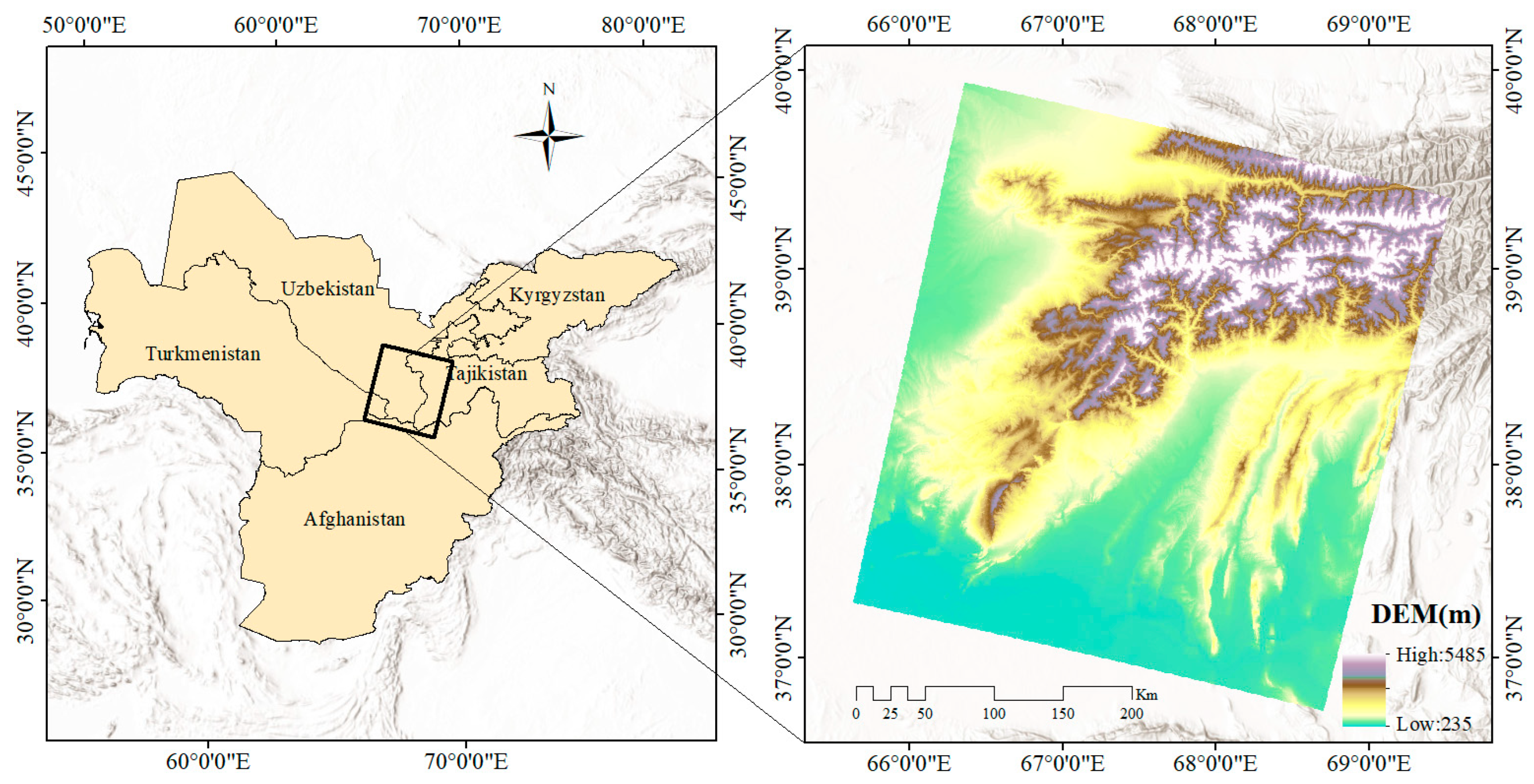
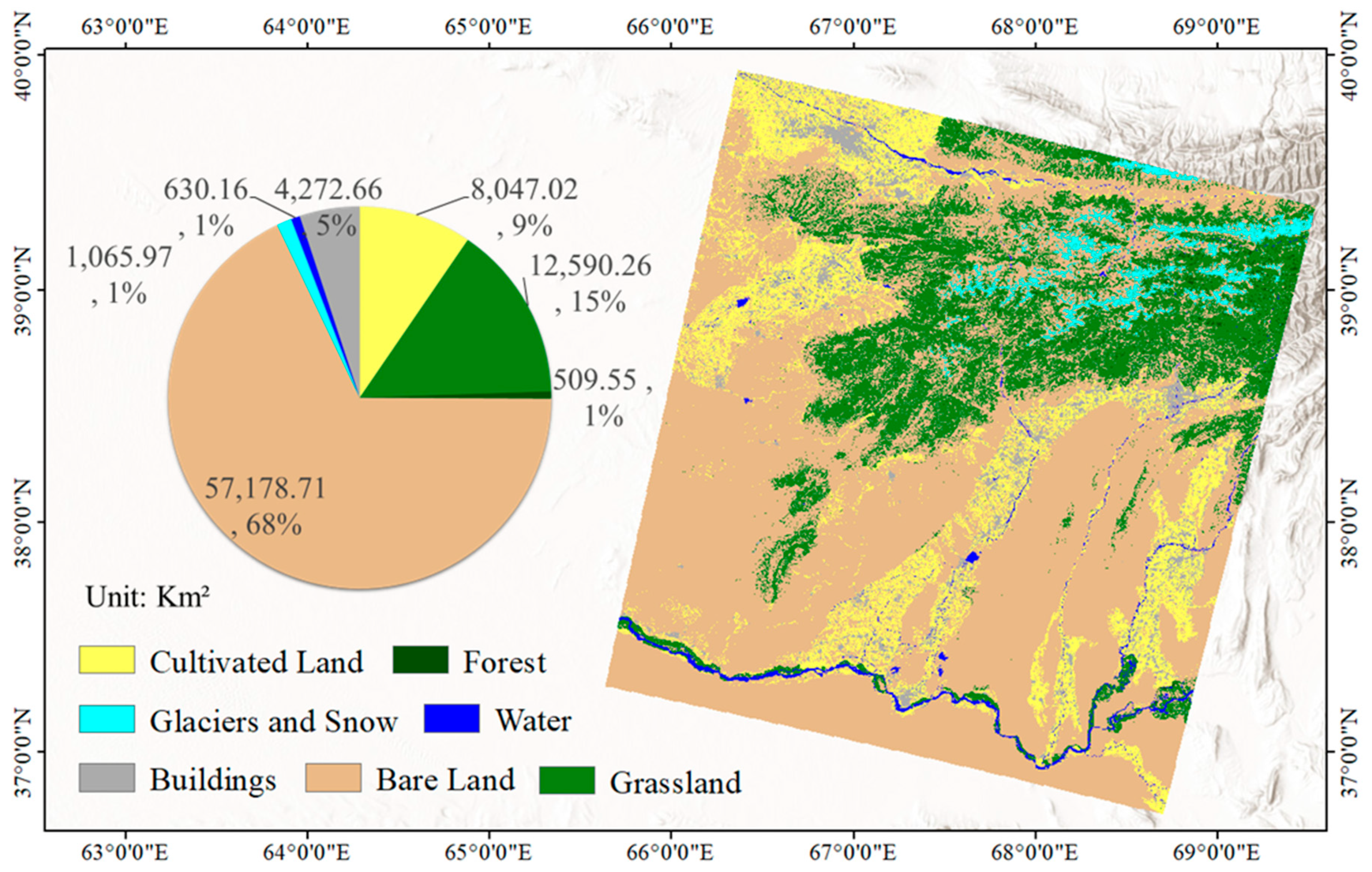

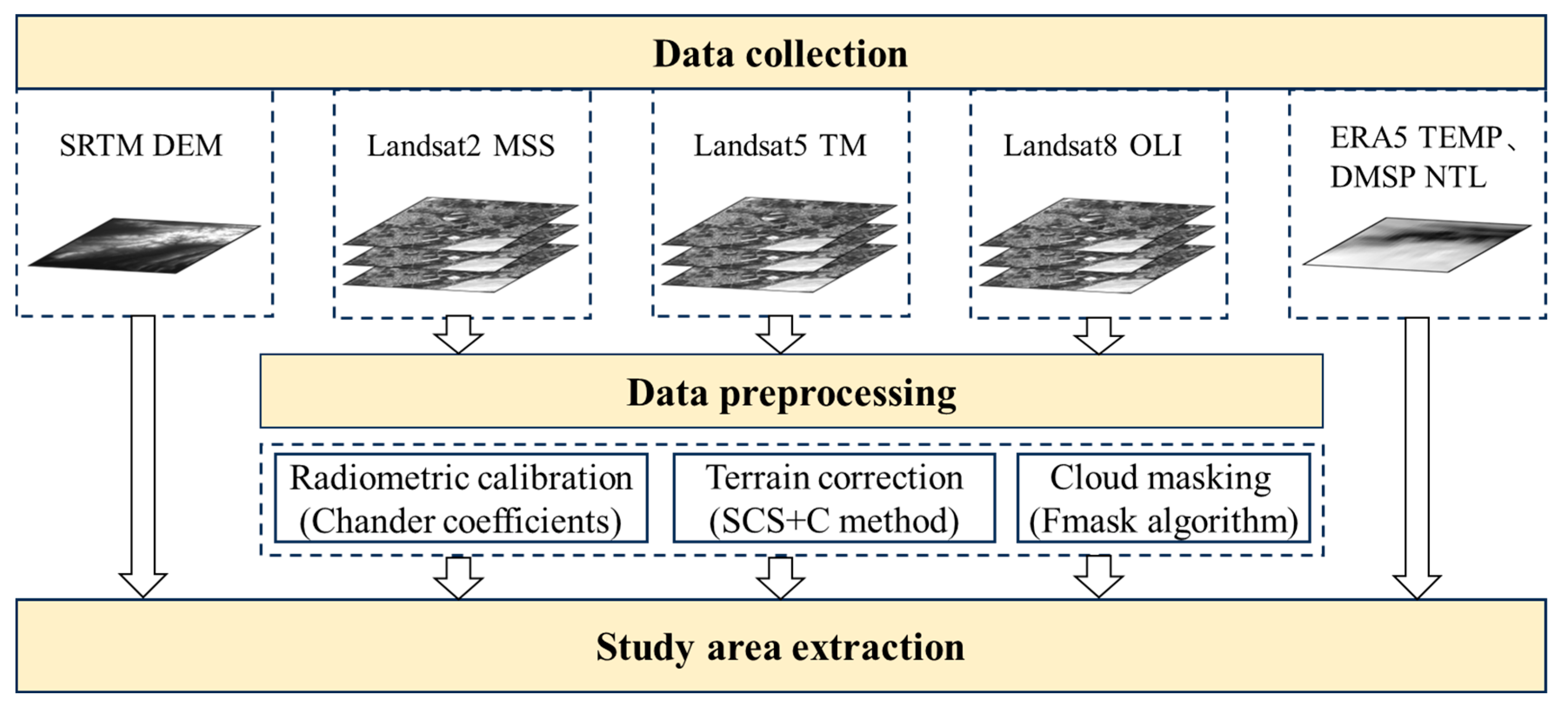

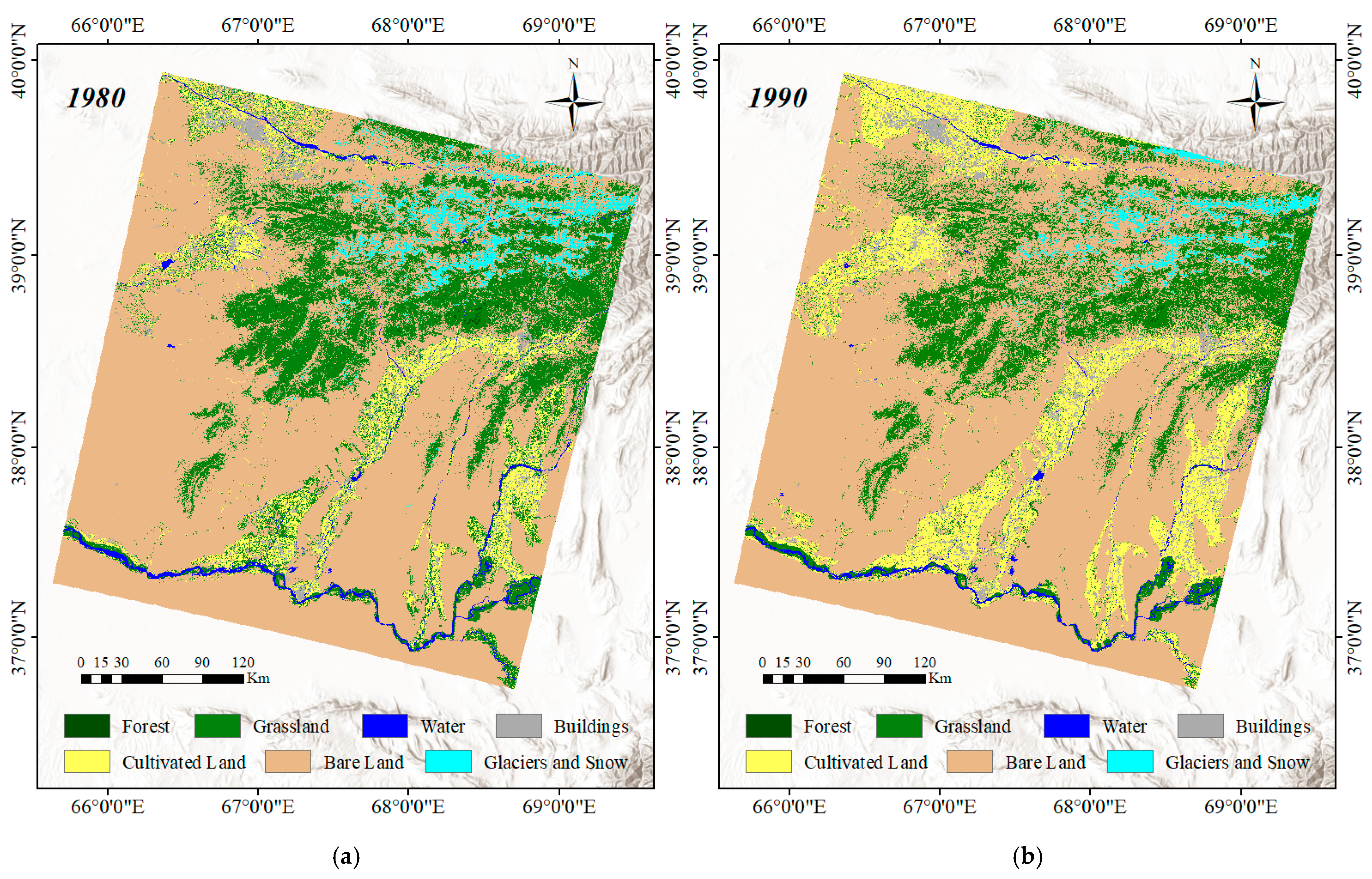
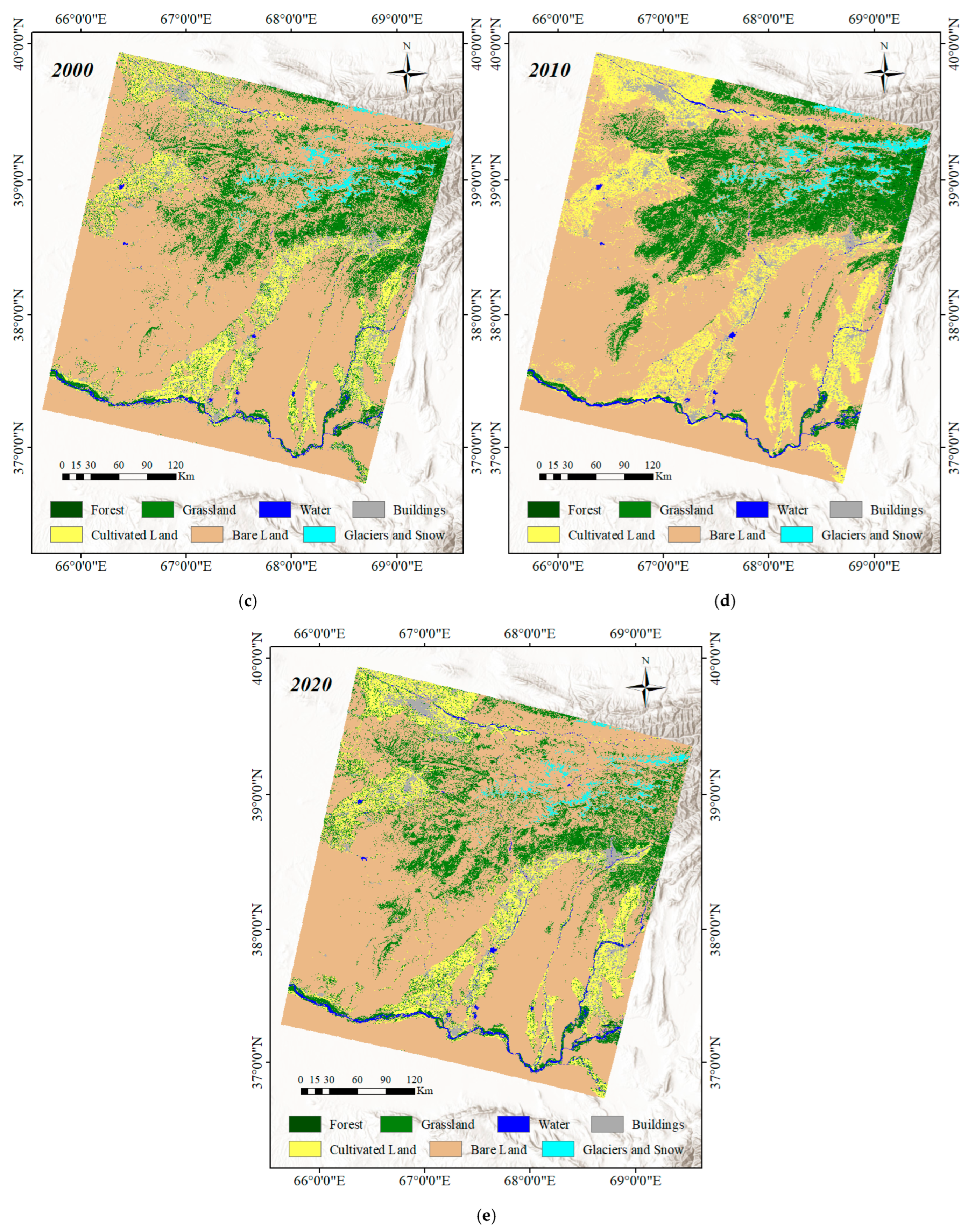

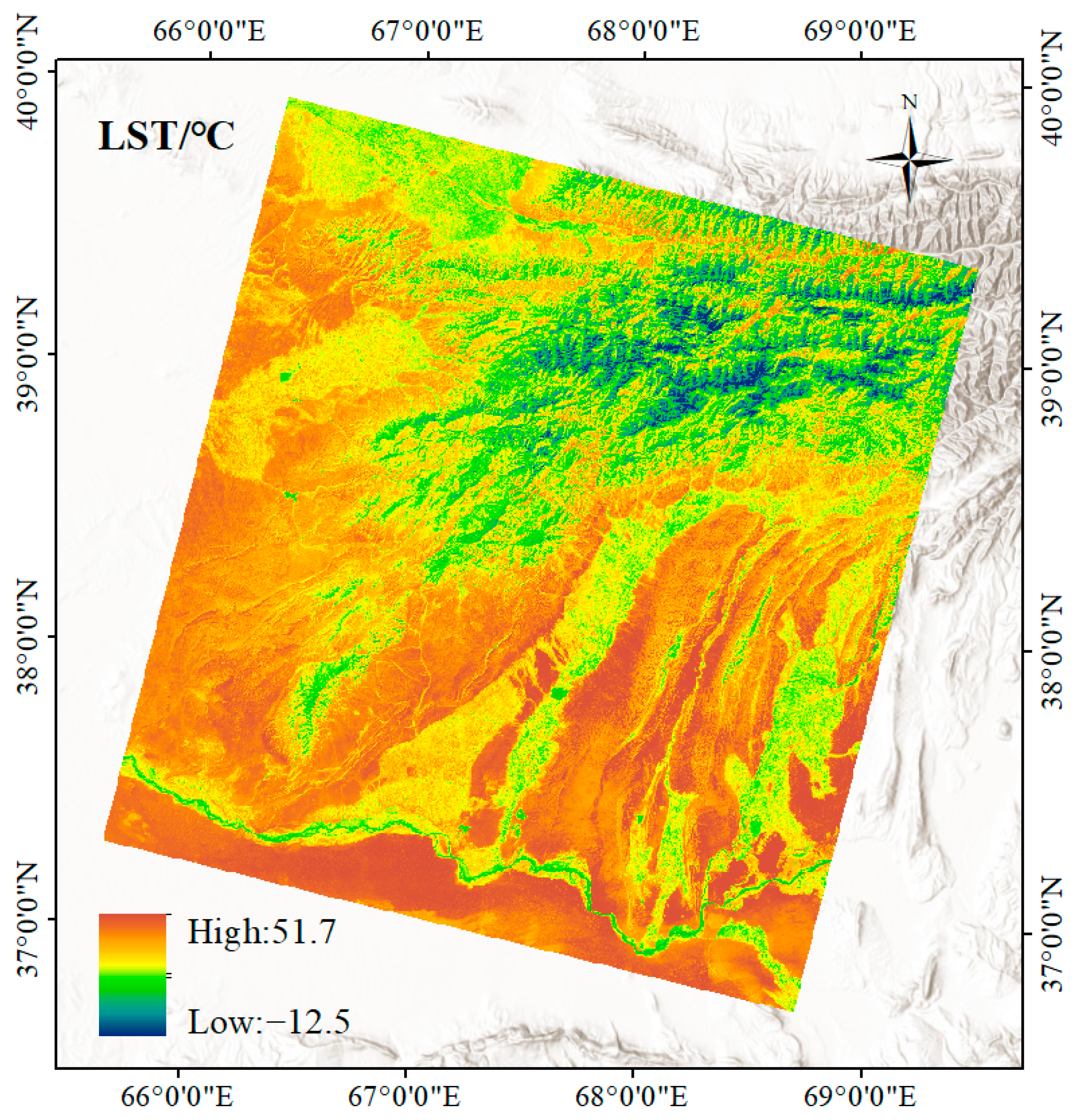

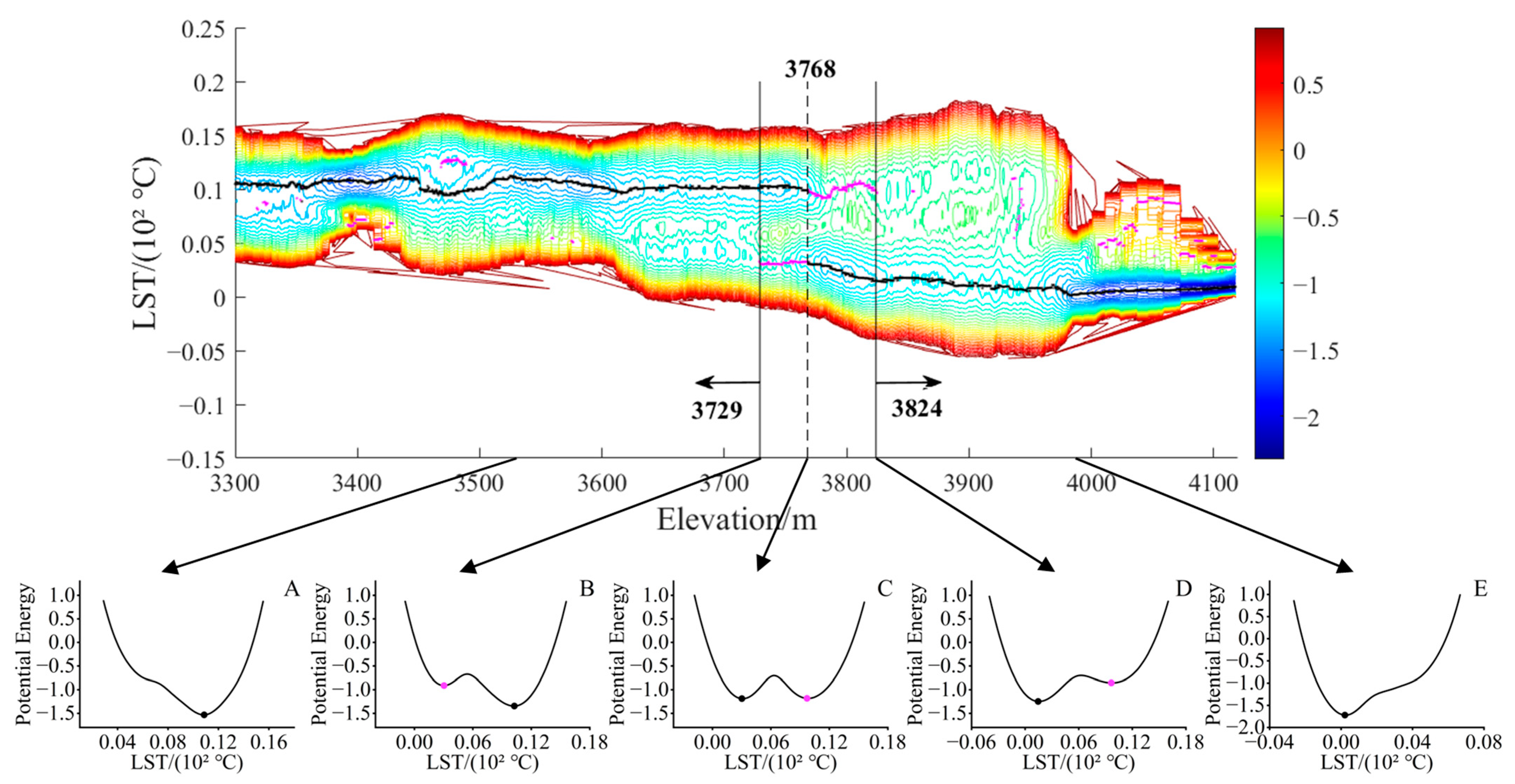
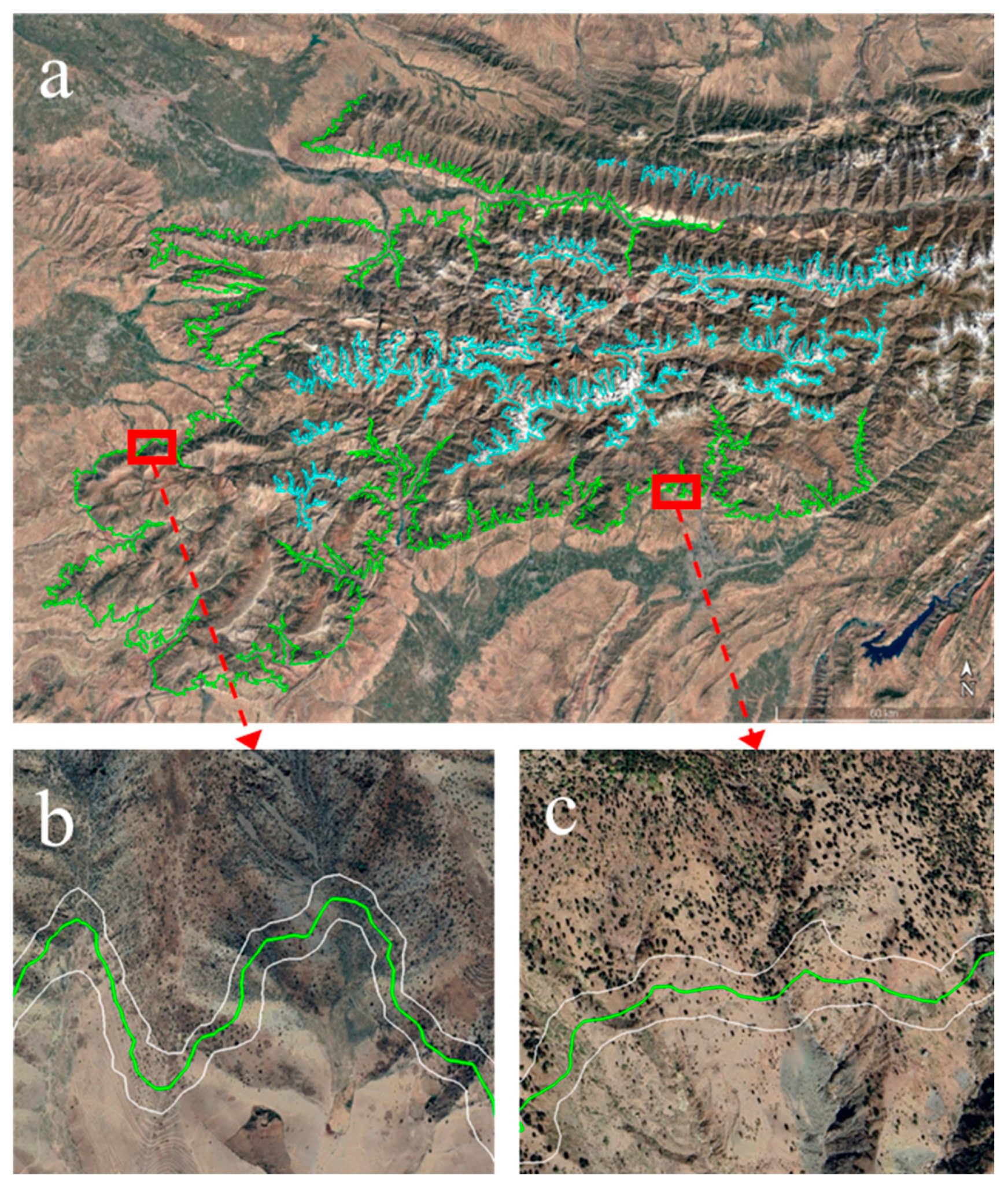
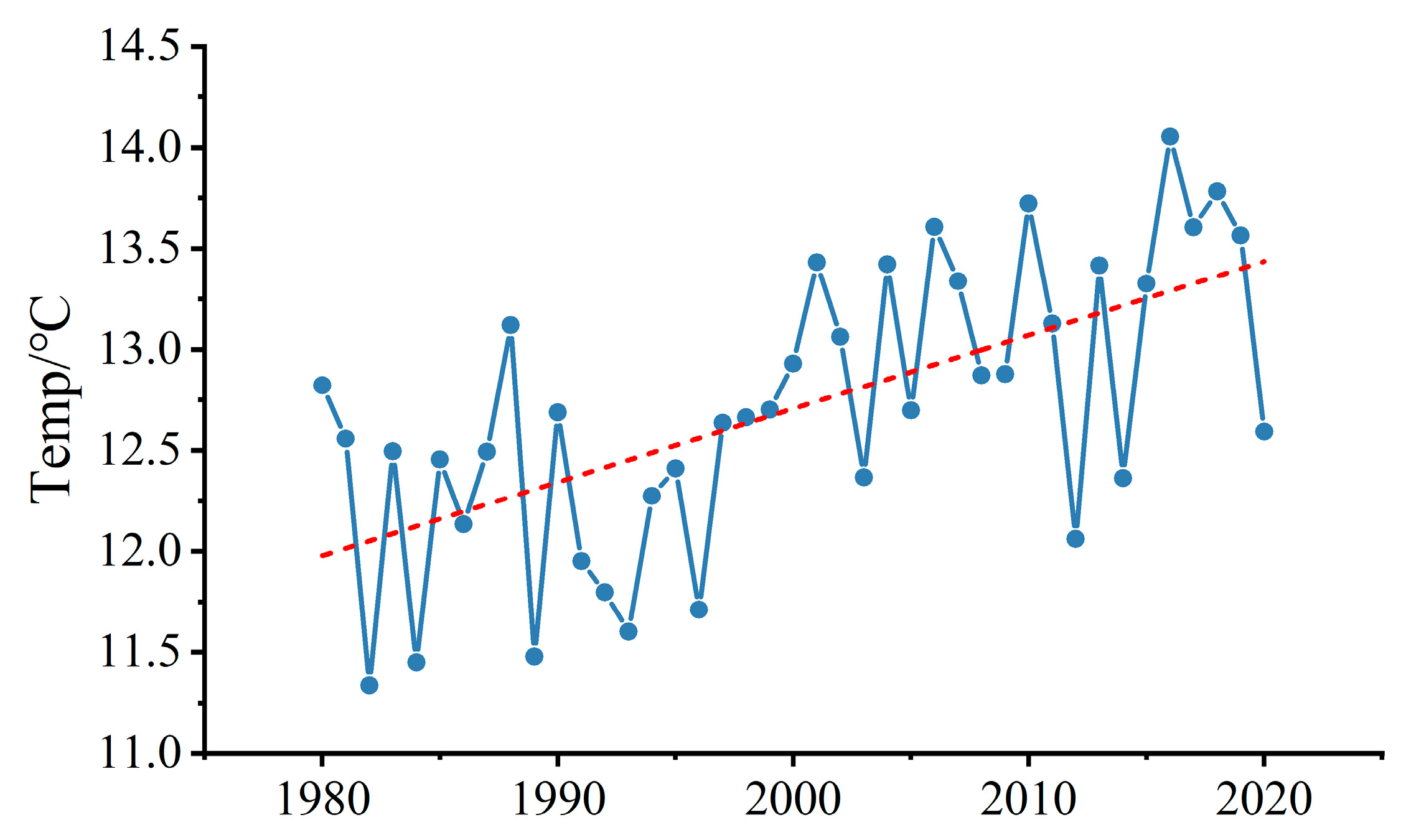
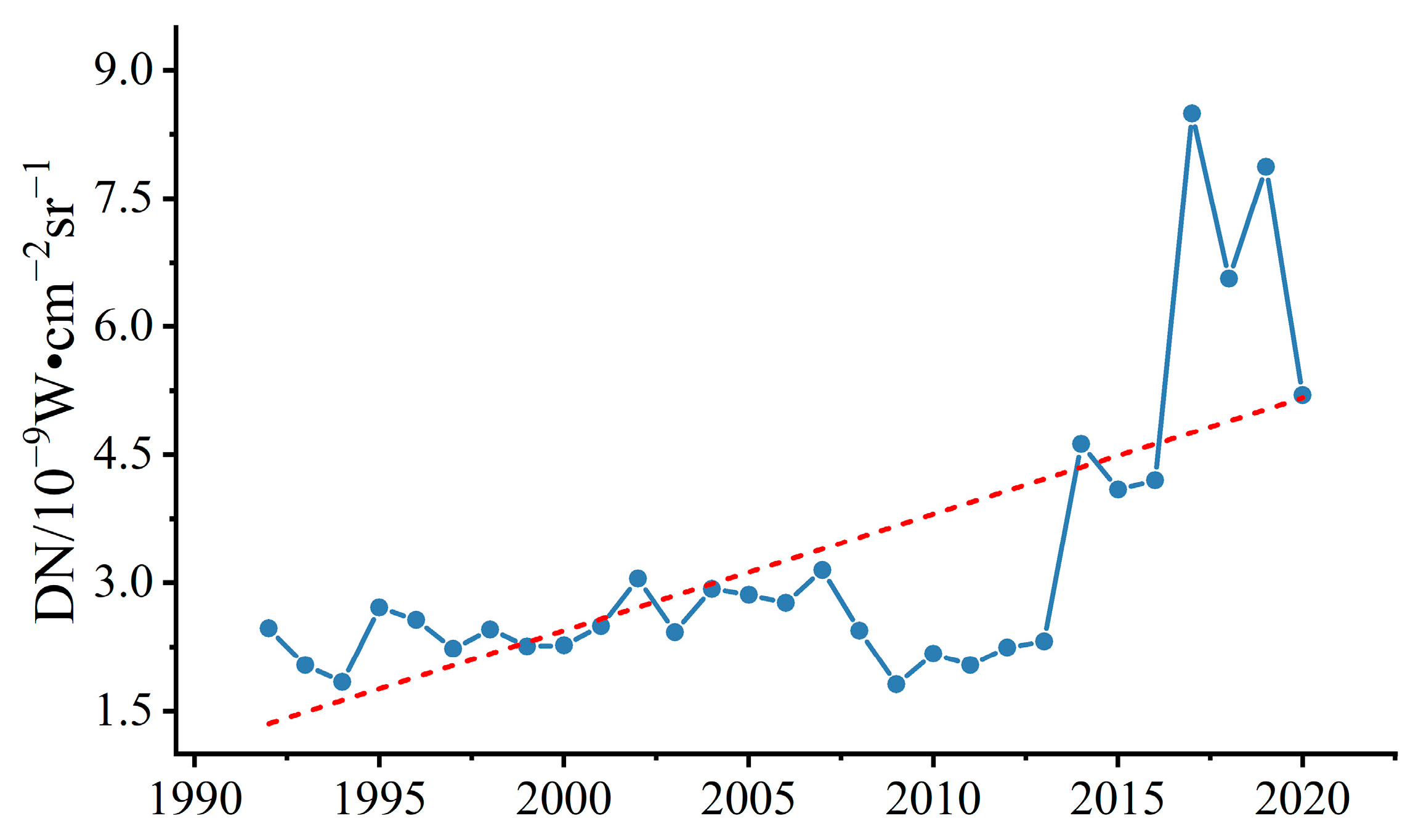
| Altitudinal Zone (m) | Mean Annual Temperature (°C) | Annual Precipitation (mm) | Vertical Zonation |
|---|---|---|---|
| <1100 | 15.91 | 1.10 | temperate desert zone |
| 1100–3250 | 6.27 | 2.40 | mountain grassland zone |
| 3250–3770 | −0.48 | 3.11 | alpine cushion vegetation zone |
| >3770 | −1.62 | 3.01 | ice/snow zone |
| Years | Temperate Desert Zone—Mountain Grassland Zone/(M) | Mountain Grassland Zone—Alpine Cushion Vegetation Zone/(M) | Alpine Cushion Vegetation Zone—Ice/Snow Zone/(M) |
|---|---|---|---|
| 1980 | 1000 | 3190 | 3680 |
| 1990 | 1010 | 3200 | 3700 |
| 2000 | 1020 | 3210 | 3720 |
| 2010 | 1050 | 3230 | 3730 |
| 2020 | 1100 | 3250 | 3770 |
Disclaimer/Publisher’s Note: The statements, opinions and data contained in all publications are solely those of the individual author(s) and contributor(s) and not of MDPI and/or the editor(s). MDPI and/or the editor(s) disclaim responsibility for any injury to people or property resulting from any ideas, methods, instructions or products referred to in the content. |
© 2025 by the authors. Licensee MDPI, Basel, Switzerland. This article is an open access article distributed under the terms and conditions of the Creative Commons Attribution (CC BY) license (https://creativecommons.org/licenses/by/4.0/).
Share and Cite
Liu, W.; Wan, H.; Guo, P.; Wang, X. Monitoring Critical Mountain Vertical Zonation in the Surkhan River Basin Based on a Comparative Analysis of Multi-Source Remote Sensing Features. Remote Sens. 2025, 17, 2612. https://doi.org/10.3390/rs17152612
Liu W, Wan H, Guo P, Wang X. Monitoring Critical Mountain Vertical Zonation in the Surkhan River Basin Based on a Comparative Analysis of Multi-Source Remote Sensing Features. Remote Sensing. 2025; 17(15):2612. https://doi.org/10.3390/rs17152612
Chicago/Turabian StyleLiu, Wenhao, Hong Wan, Peng Guo, and Xinyuan Wang. 2025. "Monitoring Critical Mountain Vertical Zonation in the Surkhan River Basin Based on a Comparative Analysis of Multi-Source Remote Sensing Features" Remote Sensing 17, no. 15: 2612. https://doi.org/10.3390/rs17152612
APA StyleLiu, W., Wan, H., Guo, P., & Wang, X. (2025). Monitoring Critical Mountain Vertical Zonation in the Surkhan River Basin Based on a Comparative Analysis of Multi-Source Remote Sensing Features. Remote Sensing, 17(15), 2612. https://doi.org/10.3390/rs17152612







